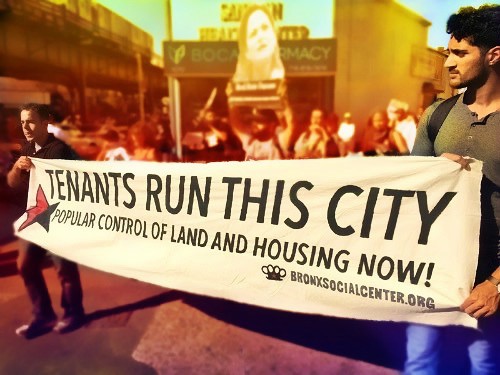
Collected Writings on Gentrification, Tenant Organizing, Rent Control and Socialized Housing
Struggles around housing, displacement, gentrification and to organize tenants are growing stronger in the current moment. In the recent past we’ve seen efforts to organize alongside tenants to wage single issue fights against landlords with solidarity networks. More recently we’ve seen efforts to form autonomous tenant unions as well as struggles over rent control and affordable housing. We hope that this evolving resource guide can inform, share strategies and analysis as well as inspire future organizing efforts. This was compiled by individuals organizing tenants in Mountain View, CA, the hometown of Google. #PowerFromBelow
Share with this link and look for updates: bit.ly/socializedhousingforall
Content
- Rent Control Talking Points/Newer Reports
- Analysis of the Crisis, Perpetrators of the Crisis
- From the Front Lines of Tenant Organizing
- Organizing Manuals and Strategy
- Policies/Gains/Reforms
- Socialized Housing Models
- Housing Policy History
- Tenant Organizing in History
- Human Stories/Images of Today’s Crisis
- Other Collections
Updated August 2019
Rent Control Talking Points/Newer Reports
The Benefits of Rent Stabilization
By Stephen Barton, former director of the City of Berkeley Housing Department and former deputy director of the Berkeley Rent Stabilization Program. Oct. 3, 2017
Clear arguments refuting common landlord talking points in the Bay Area with links to important studies at the end.
Rent Control Works: A Response to Business School Professors Misguided Attack on Rent Control
By Dean Preston and Shanti Singh, Tenants Together, March 12, 2018
Response to recent study by Stanford business school professors, which confirms that rent control prevents displacement, but blames rent control, not legal loopholes and various other factors, for rising rents: “Remarkably, the authors write an entire paper blaming rising rents on rent control, and do not even mention once that the primary tool that the city could use to prevent those citywide rent increases is vacancy control, which the real estate industry banned through statewide legislation in 1995.”
Strengthening Communities Through Rent Control
By Leslie Gordon, Urban Habitat, Jan., 2018
“The goal of this policy report is to investigate and challenge common arguments against rent control and just-cause evictions. Urban Habitat studied rent boards and policy outcomes in Berkeley, Santa Monica, and Richmond…”

Analysis of the Crisis, Perpetrators of the Crisis
Why Is There a Housing Crisis?
Richard Walker, East Bay Express
“Conservative critics, of course, denounce all popular efforts to control runaway housing costs, displacement, speculation, and bad planning as unnatural violations of some “natural law” of perfect markets. No one should be fooled by such fantasies. The real “market distortions” propelling the housing crisis are inequality, speculation, financial bloat, tax havens, and more. The day when the runaway privileges of bankers, builders, speculators, wealthy suburbanites, and the rest are reined in — that’s the day the housing crisis will be over.”
Short Circuit: Towards an Anarchist Approach to Gentrification
By “Two Toronto members” Libcom.org
A detailed analysis of how gentrification has played out worldwide: “Gentrification, etymologically speaking, is a relatively new word, coined in 1964 by the English Marxist sociologist Ruth Glass….Glass came up with the term gentrification to describe the growing displacement of residents of working-class neighbourhoods in London by middle-class property buyers, often under the auspice of “urban renewal””….”Capital doesn’t care if we feel at home somewhere. That feeling is a barrier to investment.”….by the 2000s, “Gentrification had become, in many places, something akin to a hegemony of urban space, something healthy cities aspired to, as inevitable and regular as the tides.”
What’s in My Backyard?
By Karen Narefsky, Jacobin magazine
“The YIMBY narrative rests on an idea called filtering, which maintains that even luxury construction increases affordability: as new luxury units are built, wealthier residents move into the new housing stock instead of competing for existing lower-quality housing. Apart from the condescension — should low-income people really have to wait for housing to “filter” down to them? — this framework ignores the reality of today’s housing market. Existing housing is more likely to be turned into short-term rentals through Airbnb, flipped to a condo developer, or turned into a high-end rental than it is to be occupied by a low-income family.”
Listen, Yimby! What if Your Market-Based Model is Destined to Fail? An Open Letter from Someone Who is Not a Nimby
By Tim Redmond, 48 Hills
“if housing prices dropped to the level where most working San Franciscans could afford to enter the private market, developers would stop building, because the capital would dry up. There’s more money to be made investing in places where the return is higher.”
Nimbys and the Housing Crisis
By Tim Redmond, 48 Hills
“Developers build not to meet the market demand but to meet the demands of their investors. In San Francisco in the 1980s and 1990s, it was highrise office space, not housing, that brought the highest returns to investors (often the newly deregulated Savings and Loans, that were speculating wildly in real estate, ultimately causing a huge crash that costs the US taxpayers more than $100 billion). In those days, no housing got built. I was here; I was watching. It wasn’t Nimbys who stopped housing construction in SF; it was investment capital.”
YIMBYs: The Darlings of the Real Estate Industry
By Andrew Szeto and Toshio Meronek, Truthout.org
“YIMBYs brand the activists continuing the tenant’s rights legacy as “NIMBYs” who are aligning themselves with wealthy homeowners. However, activists like Becker and McElroy, who have been in the game for much longer than Trauss and company, foresee a new wave of redevelopment like that of the 1960s and 1970s, when “urban renewal” made a few people rich, while leaving large swathes of city dwellers homeless or forced to migrate out of the areas where their families had lived for generations. In the 1960s writer James Baldwin remarked that San Francisco’s “urban renewal” of its then-Black-majority Fillmore district was “negro removal.” Under the YIMBY flag, the same is happening today with low-income Black, Latinx and transgender people of color being the core targets of displacement. The YIMBY movement’s developer allies and tech-employed urbanites stand to profit off this disruption of communities.”
The Problem with YIMBY
By Andrew Szeto and Toshio Meronek, SF Examiner
Follow up to the article above: “In the aftermath of our article’s publication, we have been the subjects of a mass doxing campaign — a common tact used by the alt-right against leftists. Our personal information has been shared widely over the internet, and our employers and publishers harassed, presumably to have us fired. If YIMBYs are so sure they are not right-wing conservatives, their actions hardly prove otherwise.”
YIMBYism and the Cruel Irony of Metropolitan History
By David Levitus, LA Streetsblog
“If we don’t tailor pro-density policies to explicitly counter a legacy of redlining of access to jobs and capital, and to preserve and create affordable housing, then the YIMBY agenda will perpetuate and not remedy the inequities that well-meaning YIMBYs intend to oppose….This essay seeks to deepen the discussion by offering a big-picture, long-term context for the debates we’re having in 2018.”
Transit-Oriented Development? More like Transit Rider Displacement
By Tracy Jeanne Rosenthal, LA Times opinion section
“On its surface, the idea makes sense: We should reward new housing near public transportation if we want to increase density and bolster rides. But rather than expanding ridership, new development is pushing riders away.”
The Permanent Crisis of Housing
By David Madden and Peter Marcuse, Jacobin magazine
“…for working-class and poor communities, housing crisis is the norm. Insufficient housing has been the mark of dominated groups throughout history…Engels was generally pessimistic about the prospects for housing struggles per se. Criticizing bourgeois attempts at housing reform, he argued that housing problems should be understood as some of “the numerous, smaller, secondary evils which result from the present-day capitalist mode of production.” … Housing and urban development today are not secondary phenomena. Rather, they are becoming some of the main processes driving contemporary global capitalism.”
Senate Bill 827, Equity, and the Need for Coalition Building in the YIMBY Movement
By Jason Islas, Santa Monica Next opinion section
“in some ways, YIMBYs — and I have been guilty of this — are discovering the housing crisis for the first time now that it has begun to impact the middle class, which is a relatively new phenomenon. Housing has always been a crisis for the poor, and there have been many activists working to address housing issues — overcrowding, displacement, unsafe and unsanitary housing — in low-income communities of color for decades. And we aren’t talking to them or incorporating their ideas into our solutions.”
From the Front Lines of Tenant Organizing
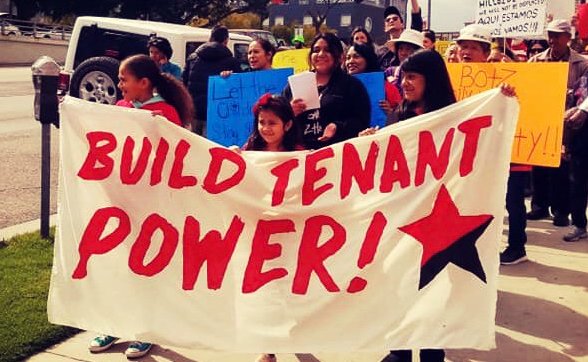
The Battle Over Rent Control in the Heart of Silicon Valley
By From Below Podcast
Interview with an organizer with the Mountain View Tenants Coalition giving the first public account of a coalition of renters and community activists organized to successfully pass a rent control measure, which rolled back rent for thousands of tenants, in the backyard of Google and other Silicon Valley tech companies. The interview details internal challenges in the organizing, the intensive counter offensive waged by landlords, and provides commentary on the failed California measure, Prop 10.
L.A.’s Class Struggle Looks Like This: The Tenants Movement
By Cameron Hughes, Salvo Newspaper
“Tenants like the Peffers, however, were unwilling to uproot their lives on the whim of a millionaire like Steven Taylor. The Peffers and several other resolved to fight. They set about talking to their equally furious neighbors, conversations which evolved into the establishment of a tenants’ association at the complex. Soon after, the tenants allied with the Los Angeles Tenants Union (LATU) – an organization founded and run by tenants hellbent on improving conditions, fighting rent increases, and identifying the city’s worst landlords.”
Tenant Power from Below: The Los Angeles Tenants Union
Interview by Jessica Lopez and Cesar Montero, Slavo Newspaper
“A multi-generational and multi-ethnic research collective, School of Echoes, spent three years studying gentrification, through readings, meetings with groups across Los Angeles, and reflecting on our own organizing work. But we did not only want to understand gentrification, we wanted to stop it. And we recognized that only a mass movement could. In 2015, we convened a host of organizers across the city to help found the LA Tenants Union. Since that meeting, we have grown to encompass nine local chapters from the Westside to the Eastside and Northeast to Southeast.”
101 Notes on the LA Tenants Union
By Tracy Jeanne Rosenthal, Commune Magazine
LATU is a horizontal movement: we build up from tenants’ associations in buildings, to local chapters in neighborhoods, to our union which spans the city. … The East Second Street Tenants Association in Boyle Heights, determined to meet weekly and act together, continued a rent strike for almost twelve months, inspired campouts at their landlord’s house, received more national press than we can count, and eventually won LATU’s first collective-bargaining agreement, which controls rent increases and secures the right to renegotiate.
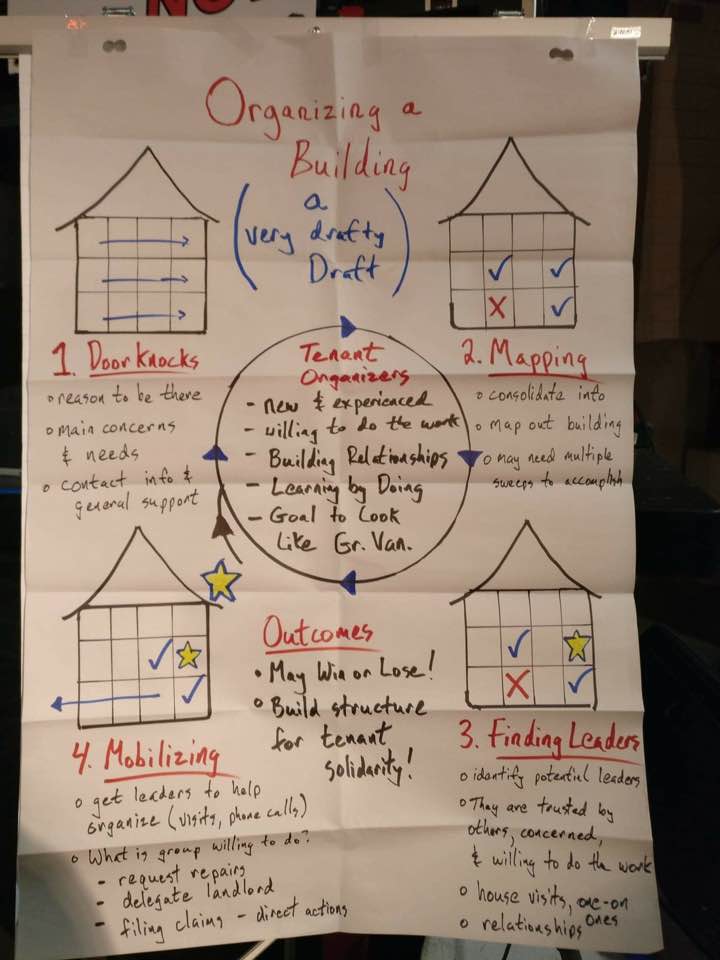
Organizing Manuals and Strategy
Organizing a Housing Complex: Steps to Getting Started
By Palm Beach County Tenants Union
A good organizing starter manual that covers the steps of identifying a neighborhood and doing research, cavassing to identify tenant leaders, and building tenant leadership.
Tactics, Vol 1
By Autonomous Tenants Union, Chicago
Zine cover common tactics used in tenant organizing such as call-ins, delegations, flyers, press conferences and more. “ATU’s work often centers around talking to tenants about their “rights” as given to them by the legal system. In our organizing, these rights are referred to as the shield. A shield can protect you, but it cannot win a fight for you. You need something more — you need the sword. We offer this zine in hopes that the tools within will help folks to go on the offensive and fight back against their landlords.”
Organizing Tenants in the Rentier Society
By Michael Byrne, ROAR magazine
“Creating this sense of collectivity is a specific goal of tenant organizations to counter the individualizing nature of renting. The DTA, for example, set out from the beginning to develop a language through which to speak to and for tenants, based closely on their experiences rather than relying on a traditional left-wing discourse to produce a readymade critique of the rental sector. This is not just a case of “representing tenants” and communicating with them, but a case of speaking as tenants.”
6 Practices to Build Community Power: An Intro to Solidarity Networks
By Brandon Feld, Portland Solidarity Network and Black Rose/Rosa Negra Anarchist Federation
“An important part to making the larger goals of broad social change attainable and realistic is building communities that can make decisions for themselves. Helping someone plan and carry out a successful campaign to get their stolen deposit back builds confidence in the idea that oppressed peoples can take back the things that are rightfully theirs, and that they don’t have to rely on lawyers or politicians to do it for them.”
Tenants Union: Fight Your Landlord and Win
A pamphlet by Buffalo Class Action, an anarchist political organization based in Buffalo, New York.
“Just as we would organize in our workplace against exploitative bosses, we propose the organization of a Citywide Tenants’ Union to organize our power to assert that decent, affordable housing is a right for all people. A City Wide Tenants’ Union should commit itself to organize all tenants of the large landlords in our city to aggressively demand our necessary rights to good quality housing. The tools of a serious Tenants’ Union are incredibly powerful:…”
Building a Solidarity Network Guide
by the Seattle Solidarity Network
“The Seattle Solidarity Network (or “SeaSol” for short) is a small but growing workers’ and tenants’ mutual support organization that fights for specific demands using collective direct action. Founded in late 2007 by members of the Industrial Workers of the World (IWW), SeaSol is directly democratic, is all-volunteer, has no central authority, and has no regular source of funding except small individual donations. We have successfully defeated a wide variety of employer and landlord abuses, including wage theft, slumlord neglect, deposit theft, outrageous fees, and predatory lawsuits.”
Rent Strikes: ‘Together We Can Defeat the Housing Market’
By Matt Broomfield, ROAR magazine
“An industrial striker does no work and so loses her pay, but rent strikers actually save money while they agitate, as astronomic rents stop crippling working people and start depreciating from the profits of housing companies. The more unbearable the financial burden on the renters, the keener the loss suddenly felt by the landlord, in an efficacious reversal of power dynamics.”
Policies/Gains/Reforms
The Myth of Non-Reformist Reform
By Robin Hahnel, from his book, Economic Justice and Democracy: From Competition to Cooperation
“…the fact that every reform success makes capitalism less harmful does not mean successful reforms necessarily prolong the life of capitalism — although it might, and this is something anti-capitalists must simply learn to accept. But if winning a reform further empowers the reformers, and whets their appetite for more democracy, more economic justice, and more environmental protection than capitalism can provide, it can hasten the fall of capitalism.”
NYC People’s Housing Plan
decolonizethisplace.org
“PREAMBLE: The People’s Housing Plan is a way for grassroots organizations, artists and activists to change the conversation about housing in New York City, moving beyond the policy goals of established nonprofit organizations and political parties.”
- End homelessness in New York City…
- Universal rent control…
- Transfer distressed buildings to tenant ownership…
- Repair and expand high-quality public housing….
- Democratize development….
People’s Housing Plan (Los Angeles)
Page 55 of the Los Angeles Tenants Union Handbook
“…we must change the conversation around housing in California.
“We must move beyond asking for crumbs and only making demands considered “realistic” and “acceptable” by the system that creates the housing crisis in the first place. We must start making demands that ask for what we really need. These six demands are a start.
WE DEMAND:
- An end to homelessness by…
- An end to all forms of housing discrimination…
- Strong universal rent control….
- Public investment in alternatives to market housing…
- Public ownership of disinvested land as well as vacant and foreclosed residences….
- Development and land use approvals that are based on social need, not speculation….”
Tierra y Libertad: California’s Prop 10 and the Fight to Build Tenant Power
By Black Rose/Rosa Negra Los Angeles
“The solution to this crisis is a new economic system organized around needs instead of profit. We need to win the generations-long fight for land and freedom. But getting there will take a long struggle of building a revolutionary renters movement through smaller confrontations with landlords where we can extract concessions and win reforms.
Proposition 10 is one of these confrontations over reforms that can move us one step closer to livable conditions for renters and building a fighting tenants movement.”
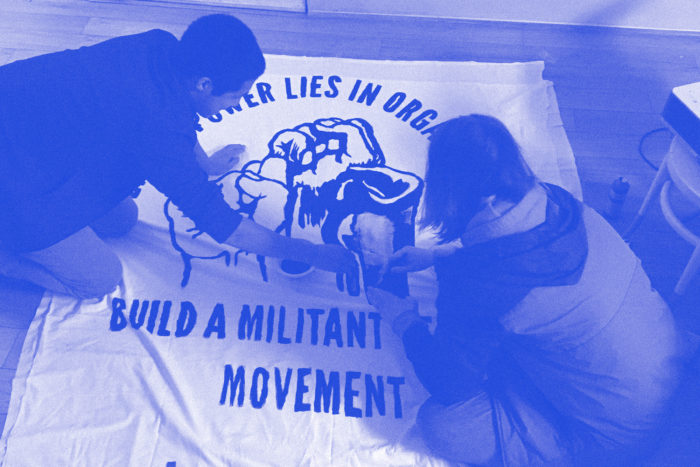
Socialized Housing Models
Communities Over Commodities
A report by Homes for All/Right to the City
“In the United States, and throughout the world, there are other models for providing housing security, and examples where communities have taken charge of housing needs through cooperative and collective arrangements that operate partially or fully outside of the market. These innovations emerged from social movements to address the root causes of housing insecurity, and as we demonstrate in this report, many models have a proven track record of success and some have impacted significant numbers of families and individuals. Despite this, U.S. elected officials and policymakers have been slow to support and explore alternative housing solutions.”
New York Apartment Guide: Rent Control vs. Rent Stabilization
By Emily Nonko, Curbed NY
“…there are laws in place to ensure that not every New York renter is left to the whims of the market, and more than 1 million apartments in the city are subject to these protections. Rent stabilization is by far the most commonly applied protection, but highly coveted rent-controlled apartments still exist in some pockets of the city, too.”
Housing Policy History
Making Rent and Rent-Making
By Alexis Zanghi, Jacobin magazine
“When the United States entered World War II, the federal government once again put rent controls in place. They continued until 1950, coinciding with one of the largest housing stock expansions in the country’s history. At that time, even conservatives considered rent control a necessary social intervention; an article in the Cornell Law Review warned that too-high rents would “create class feeling.”
Growing Up in the “Just City”
By Jennifer Baum, Jacobin magazine
“Over the years, long after my father’s sudden death in 1974, my mother resisted leaving RNA house, even when she could afford to invest in private property. Ninety-Sixth Street was where she’d set up a household with my father. It was also where she was politicized. Instead of living in a typical New York City building where individuals strove in isolation from one another, she belonged to a community where the collective action of the building’s residents underpinned her everyday experiences, shaping her life inside the building, her worldview, and her approach to society.”
Tenant Organizing History
1931: Barcelona Mass Rent Strike
By Tom Wetzel, libcom.org
“The story of one of the biggest rent strikes of the 20th century where more than 100,000 people faced down the landlords and the government winning improvements for many tenants.”
The Tenant Movement in New York City, 1904-1984
A large historical work by Ronald Lawson, published on Libcom.org
“We will encounter numerous details of street-level mobilization, of the number of tenements organized, of rent strikers, of court cases, of union members, of crowds in meeting halls, of leaflets passed out. We will have to sort through the romantic, self-serving claims, some of them grown to movement myths, from the hard facts. Many remain too elusive to pin down. Some come from first-person reminiscences, a fascinating oral history. But the accounts are often thirty, even forty years old; some inevitably blend hazy recollections of 1937 with those of 1947. They demand corroboration with the written record. Admittedly, this reliance on literary evidence means reliance on those middle-class liberals who left a solid accounting and who usually staffed the government and reform agencies that tenants often confronted. There seems to be no way around this obstacle except to reckon with its biases and make the best of its legacy, to balance written reports with movement claims to recruitment and influence. We will be on safe ground if we judge the tenant movement by the same hard standards that its leaders would have applied to its operations — whom did it influence, what policies did it bring about, what results did it accomplish?”
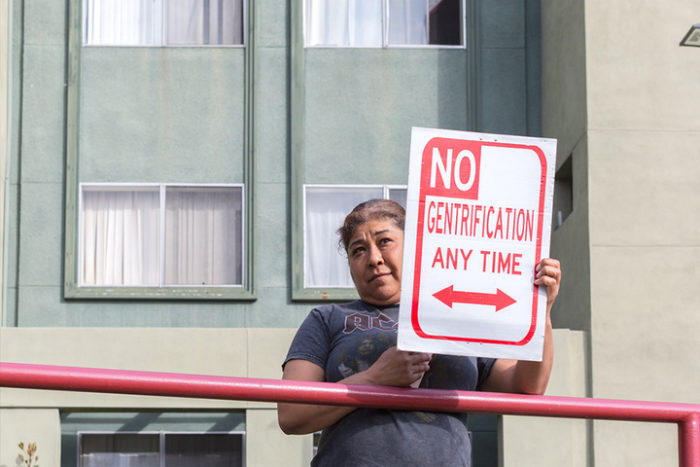
Human Stories/Images of Today’s Crisis
A San Jose Google Campus will Erase My Existence
By Daniel A. Gonzales, SV De-Bug
“I feel like Mayor Sam Liccardo and his partners are bringing pain and suffering to my doorstep, and that I’m fighting for survival. I’m fighting for home, and home is everything. It is identity, it is community, it is family. Without these things I am nothing, I don’t exist.”
Facing Poverty, Academics Turn to Sex Work and Sleeping in Cars
by Alastair Gee in San Francisco, The Guardian
“I feel committed to being the person who’s there to help millennials, the next generation, go on to become critical thinkers,” she said. “And I’m really good at it, and I really like it. And it’s heartbreaking to me it doesn’t pay what I feel it should.”
Homeless San Jose State Professor Struggles Living Out Of Her Car CBS local news, with video
“James-Penney used to be an admin in high tech, but was laid off in the dot-com bust and was forced to live on her savings. She went back to school and paid tuition with student loans. “I’m $143,000 in debt. And I’m in my 50s. But I pay that loan back every month,” said James-Penney. “That is mandatory for me. But that chunk I pay also affects how much I can afford in rent.”
Living Under a Tarp Next to Facebook HQ: ‘I Don’t Want People to See Me’
By Alistair Gee, the Guardian
“The sprawling Silicon Valley campus has cafes, bike repair services, even dry cleaning. But across the road a homeless community epitomizes the wealth gap”
‘It’s a Catastrophe’: Low-Income Workers get Priced Out of California Beach City
By Sam Levin, Guardian
“California is a monster. If you don’t keep up, you end up on the streets, and nobody cares,” said Kahn, a college graduate who previously worked two jobs in Santa Cruz. “This is a public health issue. It’s a catastrophe.”
Other Collections
Gentrification is Displacement and Replacement of the Poor for Profit
A large syllabus by the School of Echoes/Co-founders of the LA Tenants Union
“This syllabus starts from the assumption that housing is a human right, that every person has the right to a safe and affordable place to live. Housing is much more than shelter: it is our connection to our communities, even our sense of self. This syllabus draws together a host of readings that explore the profound contradictions between the economic use of housing—for profit and speculation—and this social use.”
Yes on Measure V FAQ and resources
From the victorious 2016 campaign for rent control in Mountain View, CA. — collected resources and a FAQ responding to common concerns about rent control:
“Rents have nearly doubled in only the last seven years in Mountain View, fueled by real estate speculation and extreme job growth. Rent increases of $1,000 a month are all too common. These rent hikes have driven out our friends, family members and the diverse people who make Mountain View great. Measure V curbs this with….”
If this resource guide was useful then you might enjoy additional articles and audio interviews related to strategy, socialist strategy and movements.
